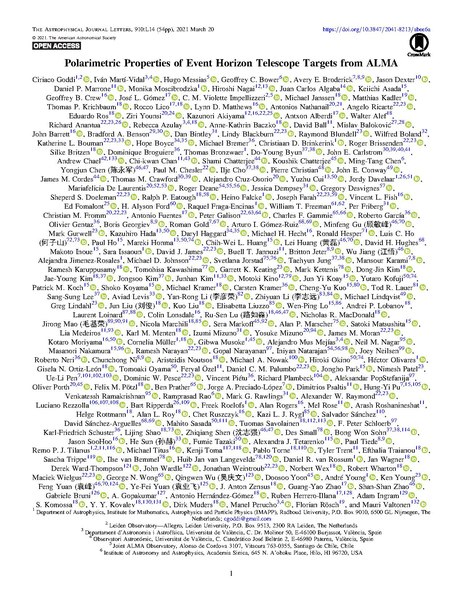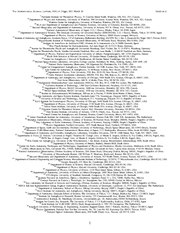File:Goddi 2021 ApJL 910 L14.pdf
From Wikimedia Commons, the free media repository
Jump to navigation
Jump to search

Size of this JPG preview of this PDF file: 463 × 599 pixels. Other resolutions: 185 × 240 pixels | 371 × 480 pixels | 593 × 768 pixels | 1,275 × 1,650 pixels.
Original file (1,275 × 1,650 pixels, file size: 5.54 MB, MIME type: application/pdf, 54 pages)
File information
Structured data
Captions
Captions
Polarimetric Properties of Event Horizon Telescope Targets from ALMA
Summary[edit]
| DescriptionGoddi 2021 ApJL 910 L14.pdf |
English: We present the results from a full polarization study carried out with the Atacama Large Millimeter/submillimeter Array (ALMA) during the first Very Long Baseline Interferometry (VLBI) campaign, which was conducted in 2017 April in the λ3 mm and λ1.3 mm bands, in concert with the Global mm-VLBI Array (GMVA) and the Event Horizon Telescope (EHT), respectively. We determine the polarization and Faraday properties of all VLBI targets, including Sgr A*, M87, and a dozen radio-loud active galactic nuclei (AGNs), in the two bands at several epochs in a time window of 10 days. We detect high linear polarization fractions (2%–15%) and large rotation measures (RM > 103.3–105.5 rad m−2), confirming the trends of previous AGN studies at millimeter wavelengths. We find that blazars are more strongly polarized than other AGNs in the sample, while exhibiting (on average) order-of-magnitude lower RM values, consistent with the AGN viewing angle unification scheme. For Sgr A* we report a mean RM of (−4.2 ± 0.3) × 105 rad m−2 at 1.3 mm, consistent with measurements over the past decade and, for the first time, an RM of (–2.1 ± 0.1) × 105 rad m−2 at 3 mm, suggesting that about half of the Faraday rotation at 1.3 mm may occur between the 3 mm photosphere and the 1.3 mm source. We also report the first unambiguous measurement of RM toward the M87 nucleus at millimeter wavelengths, which undergoes significant changes in magnitude and sign reversals on a one year timescale, spanning the range from −1.2 to 0.3 × 105 rad m−2 at 3 mm and −4.1 to 1.5 × 105 rad m−2 at 1.3 mm. Given this time variability, we argue that, unlike the case of Sgr A*, the RM in M87 does not provide an accurate estimate of the mass accretion rate onto the black hole. We put forward a two-component model, comprised of a variable compact region and a static extended region, that can simultaneously explain the polarimetric properties observed by both the EHT (on horizon scales) and ALMA (which observes the combined emission from both components). These measurements provide critical constraints for the calibration, analysis, and interpretation of simultaneously obtained VLBI data with the EHT and GMVA. |
| Date | |
| Source |
https://iopscience.iop.org/article/10.3847/2041-8213/abee6a https://doi.org/10.3847/2041-8213/abee6a |
| Author | Ciriaco Goddi et al. |
Licensing[edit]
This file is licensed under the Creative Commons Attribution 4.0 International license.
- You are free:
- to share – to copy, distribute and transmit the work
- to remix – to adapt the work
- Under the following conditions:
- attribution – You must give appropriate credit, provide a link to the license, and indicate if changes were made. You may do so in any reasonable manner, but not in any way that suggests the licensor endorses you or your use.
This file, which was originally posted to
https://iopscience.iop.org/article/10.3847/2041-8213/abee6a, was reviewed on 8 September 2023 by reviewer Юрий Д.К., who confirmed that it was available there under the stated license on that date.
|
File history
Click on a date/time to view the file as it appeared at that time.
| Date/Time | Thumbnail | Dimensions | User | Comment | |
|---|---|---|---|---|---|
| current | 08:49, 25 March 2021 |  | 1,275 × 1,650, 54 pages (5.54 MB) | Pamputt (talk | contribs) | Uploaded a work by Ciriaco Goddi et al. from https://iopscience.iop.org/article/10.3847/2041-8213/abee6a https://doi.org/10.3847/2041-8213/abee6a with UploadWizard |
You cannot overwrite this file.
File usage on Commons
There are no pages that use this file.
Metadata
This file contains additional information such as Exif metadata which may have been added by the digital camera, scanner, or software program used to create or digitize it. If the file has been modified from its original state, some details such as the timestamp may not fully reflect those of the original file. The timestamp is only as accurate as the clock in the camera, and it may be completely wrong.
| Short title | Polarimetric Properties of Event Horizon Telescope Targets from ALMA |
|---|---|
| Image title | The Astrophysical Journal Letters, 910(2021) L14. doi:10.3847/2041-8213/abee6a |
| Author | Ciriaco Goddi |
| Keywords |
|
| Software used | IOPP |
| Encrypted | no |
| Page size | 612 x 792 pts (letter) |
| Version of PDF format | 1.7 |
